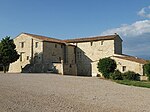The Jules Horowitz Reactor (Réacteur Jules Horowitz, RJH) is a materials testing reactor (MTR) cooled and moderated with water. It is under construction at Cadarache in southern France, based on the recommendations of the European Roadmap for Research Infrastructures Report, which was published by the European Strategy Forum on Research Infrastructures (ESFRI) in 2006. The reactor, which is named for the 20th-century French nuclear scientist Jules Horowitz.
The reactor is designed to have a good neutron economy that results in large numbers of thermal neutrons being available around the outside of the reactor core. The neutrons from this source can be used in many materials testing and other experimental roles. The system also allows samples to be inserted directly into the core, where they are exposed to high-energy neutrons, which is useful for isotope preparation. Similar reactors were common in the 1950s and 60s, but most have reached the end of their practical lifespans, and few new ones have been commissioned. This has led to a crisis in the worldwide supply of medical isotopes, one of the major roles of the JHR.
Site preparation began in 2007, followed by the first concrete in the summer of 2009. The central containment structure was completed with the addition of a 105-tonne (103-long-ton; 116-short-ton) dome in December 2013. At the time it was predicted the system would be operational in 2014. Since then the site has suffered from significant delays, leading to a complete re-organization of the management. Current estimates suggest first criticality sometime after 2030.









